-

人教版高中英语必修1Nelson Mandela--A Modern Hero说课稿
In this step, give students a few minutes to read the passage . While they are reading, I will write some key words of the text on the blackboard. Then ask students to retell the passage according to the key words.By retelling, students can improve their ability of language organization and have an overall understanding of the article.Step 4 Group discussionIn this step, students will be divided into groups of 4 to discussion the following question: What qualities make a great person?After their discussion, invite a few groups to make a report to the class.This group discussion can practice students’ oral English and cultivate their abilities of cooperation and communication.Step 5. HomeworkLet students write a short passage to introduce a great person he or she admires.The homework can consolidate the knowledge the students have learned and cultivate their writing ability. Part 6 Blackboard Design(板书设计)That’s all my teaching procedures. Finally, I’d like to say sth about part 6 blackboard design. On the top is the title. On the left, there will be some new words and expressions. In the middle of the blackboard, I will write some useful sentence structures so that the students can know clearly what they’ve learned and then try to master the knowledge.OK. That’s all for my presentation. Thank you for your attention.

人教版高中英语必修2Computers说课稿3篇
一. 教材分析1. 本单元的中心话题是“计算机(Computers)”,内容涉及计算机的发展历史,计算机的应用等。本节课是该单元的第一课时,我将Warming up, Pre-reading and Comprehending这四部分整合为一节精读课。其中。Reading部分是题为WHO AM I?的文章,以第一人称的拟人手法介绍了计算机发长演变的历史和计算机在各个领域的应用,其主旨是表达计算机的发展变化之快以及在生活中用途之广。而Warming up部分以图片的形式展现了计算机的发展历程;Pre-reading中的问题和排序分别是为了预测语篇的内容和测试学生对计算机历史了解的情况;Comprehending则通过各项练习训练学生的阅读技能,从而加深对文章的理解。可见这几部分是一个有机的整体。2. 教学目标:1) 语言目标:重点词汇及短语:abacus, calculate, calculator, PC, laptop, PDA, robot, analytical, technological, universal, mathematical, artificial, intelligent, network, explore, in common, as a result.重点句子:a. My real father was Alan Turing, who in 1963 wrote a book to describe how computers could be made to work, and build a “universal machine” to solve any mathematical problem.

人教版高中英语必修2Cultural Relics说课稿2篇
Ⅲ. Analysis of the teaching material:The topic of this unit is cultural relics. Students are quite interested in topics about different cultures around the world. This is the second period of the whole unit. As a reading class, the passage mainly talks about the history of the amber room (how it was made, sent as a gift, lost and rebuilt).According to the new national curriculum, when teaching reading, much emphasis should be put on training the students’ reading skills.Ⅳ. Teaching objectives1. Language objectives:1) Students are required to master the key words and phrases occurred in the passage (e.g. amazing, decorate, belong, in return, less than etc.)2) Students are required to learn the attributive clause and acquire the sentence pattern.2. 1) Students are required to describe a certain thing by using the new sentence patterns.2) Students are required to master two kinds of reading skills—skimming and scanning, and learn to use them in their daily reading.3. 1) Students are required to know the history of the amber room.2) Students are required to appreciate cultural relics and understand the importance of protecting them.Ⅴ. Teaching important and difficult points1) the new words, phrases, and sentence pattern in the course of reading.2) Teaching difficult point: Help the students master two kinds of reading skills—skimmingand scanning and learn to apply them in daily use.Ⅵ. Teaching methods:Task-based method & Top-down model Ⅶ. Teaching aids: PPT, pictures, blackboard Ⅷ. Teaching procedure:

人教版高中英语必修3Astronomy the science of the stars说课稿3篇
Step 2 Pre-listeningAfter students finish their discussion, I will show a picture of Newton and ask them: Who is him? What is he famous for? Could you find out some words to describe him? Maybe students will answer that he is genius for his finding of theGravitation, making a great contribution to the progress of human being. At that time I will show another two pictures of Einstein and Hawking, letting students guess who they are and write down their idea about the Gravitation. For I have arranged them to search more information about the gravity before this class, Students have beenfamiliar with the topic and will not be afraid about this abstract conception, which is helpful for their listening.Step 3 While-listeningIn this step, students will be required to listen the material for three times. The first and listening is extensive listening and the second and third listening is intensive listening. In the first time, They are required to listen a material including Part 1 and Part 2 and choose the best summary of the listening text. After they choose the right answer, They also need work in group to explain what is wrong with the others. Then I will make a conclusion that we should pay attention to the first paragraph and last paragraph and some keys to get the main idea. By doing this, their capacity of generalization will have a great improvement.Before the second listening, I will ask students to scan the blank on the power point quickly and ask them to note down some key words .Then ask them to listen to the Part 1again and fill the first column of the chart. Maybe some students just show the ideas of these three scientists an still can’t catch their development of gravity. Therefore, I will ask them to listen to Part 2 again and fill in the rest. After finish the listening, I will give them ten minutes to discuss with their partner. I will also guidethem to improve their answers when they discuss with others.

人教版高中英语必修4A taste of English Humor说课稿3篇
Then I would ask them to think of a funny English or Chinese and tell it to partners. While telling stories, they can use expressions and some acting to help make the story funny. 5 minutes would be given to do this.Those stories they told there will be the material for their writing. Soletting them tell it at first is helpful. And they can make a difference between telling a funny story and writing it down. Generally speaking, it is difficult forstudents to write well because they don’t know what to write and how to write. Asking them to tell their own stories at first can help them come up with what to write.After their telling, I would invite someone to share his/her story with all of us and I would write it down on the blackboard.This example story would be used as a sample to illustrate the format of funny story. Different from a story from teacher or textbook, a story from students can obviously become a interesting material to draw students’ attention.Then I would ask the whole class to put this story into several parts. It might be a little bit difficult for them. So I would ask them to find out whether all the sentences are necessary. After delete some sentences, there are 6 sentences left behind. Then they can easily put them into three parts. After interaction with students, I would teach them the right terms for each part and conclude the format of funny story.This step is the key and difficult point in my lesson. So I mainly usetask-based teaching method in this part and the task for students was divided into several stages. With the separated difficult level, students can find there are usually three parts in writing. They can also learn to write without the unnecessary parts in the process of analyzing. And then I wouldn’t rush to tell them the right terms to them directly. Instead, I would ask them to name them by their own. A confused mind is better for acquiring knowledge.While-writing:Then I would give students 7 minutes to write down this story, without other requirements.With all the preparations in pre-writing, students’ difficulties were cleared. So it would be much easier for them to write down the story within 7 minutes. There are no other requirements because students’ first writing is actually a drafting. It would be revise and edit several times later. Writing, as a skill

人教版高中英语必修4Women of achievement说课稿4篇
Good morning, distinguished judges:It’s my honor to talk about my teaching ideas with you. Today my topic is Women of Achievement. My presentation consists of six parts: the analysis of teaching material and student, teaching aims, key and difficult points, teaching and studying method, teaching procedures and blackboard design.First, let’s focus on the analysis of teaching material. This lesson is from New Senior English for China Student’s Book 4 Unit 1, the reading part. The main topic of the passage is the introduction of a student of Africanwildlife. After this lesson, the students will learn more information about her studying chimps in Africa, and their reading and speaking abilities can be developed as well.The next part is the analysis of students. My students are in senior high students. They have learnt English for many years, they’ve known many words and sentences, but their speaking and reading abilities are still not very good. So I will practice their speaking and reading abilities through different exercises.According to the New Standard Curriculum and the present situation, I set the teaching aims as follows: firstly, knowledge aims. Students can grasp some new words, such as worthwhile, move off. Moreover, students can understand the content of the passage and get familiar with the topic of studying chimps in wildlife. Secondly, ability aims. Students can use reading strategies such as skimming and scanning in reading process. Thirdly, emotional aims. Students can have the awareness of protecting animals and care about animals.Based on the above analysis, the key point of this lesson is to get the main idea and the detailed information from the passage; the difficult point is to talk about the wildlife protection and use reading strategies.

人教版高中英语必修4Theme parks说课稿3篇
The oldest and the most popular park in the worldenjoy the exciting activities thereget close to the life-size cartoon characters like Mickey Mouse and Donald Duck Step 3 Pre-reading1.What do you suppose a theme park is ?2.What do you think you can see in a theme park?(1.It is a kind of amusement park which has a certain theme – that the whole park is based on. 2.buildings, castles, statues, rare animals and birds, and so on.) Step 4 Reading ----- Theme Parks –---- Fun and More Than Fun1.Predict : Read the title and the pictures on P. 34 and PredictWhat is the meaning of the title “Theme Park – Fun and more than fun”?(The title means that theme parks are fun to visit, but that they can also be educational and can offer useful information.)2.Skimming Fast read and answer:What activities can we take in a theme park?Amusement park: Bumper car Merry-go-round slide bungee jumping Free-fall rides Horror films Pirate ship Ferris wheel roller coaster3.Scanning Read again and you will find various theme parks are mentioned in the passage . Then what are they ?Theme parks: Sports theme park History theme park Culture theme park Marine or Ocean theme Park Future park Science theme park Disneyland4.Careful reading and find the main idea of each paragraph:THEME PARKS---- entertaining/ educationalPara.1 Traditional parks are places to go for relaxation and to have time away from our busy lives.Para.2 Theme parks are different They’re large and full of things to do, see and buy.Para.3 Theme parks are built around a single idea or theme. One example is a sports park.Para.4 Another kind of theme park is historical more and cultural and can be educational.Para.5 Disneylandwas the first theme park. It is based on the fantasy life and characters of Disney’s films.Para.6 Some examples of educational theme parks include sea world parks and science parks.

人教版高中英语必修4Working The Land说课稿3篇
Knowledge objectives:(1) to make Ss grasp the usage of words, expressions and sentence structures: statistics, struggle, thanks to, rid of, some patterns for persuasion, the “ing” form as subject and object;(2)to use learnt knowledge to persuade sb.Ability objectives:(1) to develop Ss’ reading skills(skimming, scanning, word guessing);(2) to improve Ss’ speaking, communicating and cooperating skills.Emotional objectives:to make Ss know the contribution of Yuan,and learn his spirit and his simple life time.Teaching important and difficult points:(1) some words, expressions and sentence structures mentioned above;(2)the content of the text;(3)training their reading and speaking skills.Teaching methods: CLT, TBLT,QT.Learning strategies: CLS, QLS, TBLS.Teaching procedures:Step 1 lead-in: (1) teacher plays a piece of recent news from CCTV about the harvest of the super hybrid rice, and ask students whether they know Yuan or not, and talk about him and his contribution.(2)Brain storm: let Ss describe Yuan in their minds including his appearance, his living condition and so on.Step 2 fast reading tasks:(1)teacher introduces Yuan and super hybrid rice(2)make Ss read the text as fast as possible with questions. Such as: what’s the general ideaof this passage? What’s Yuan’ dream? (skimming and scanning skill)Step 3 intensive reading tasks(1)let Ss read the text silently, find topic sentence of each paragraph and draw the difficult sentences and the knowledge what they don’t understand.(words guessing)(2)teacher and Ss talk about the important words, expressions and sentences together, and ask Ss to retell the content of the text.(summarizing and paraphrasing)(3)teacher summarize this part.(4) read again following the courseware.

人教版高中英语必修5First aid说课稿6篇
In this class, I have 3 teaching aims, that is, knowledge aims, ability aims and emotion aims.1) Knowledge-Teach students new words and expressions, such as temporary, bleed,sprain choke, first aid, fall ill and so on.-Enable students to have a better understanding for some basic knowledge of first aid.2) Ability-Train students’ speaking, reading and writing abilities by different teaching activities, such as skimming, comprehending, team work, role play, retelling and writing.-Develop students’ reading strategy on how to move general idea to specific information.3) Emotion-Promote students’ awareness of giving first aid.- Cultivate students’ creativities.Then let’s come to my teaching methods and activities.III. Teaching methods and activities:To achieve different teaching aims, various kinds of teaching methods and activities will be adopted throughout this period, such as TBL (task-based learning), skimming, team work, brainstorm and others, which can offer students opportunities to fulfill tasks in which they can use language to achieve a specific outcome.IV. Teaching aids:Computer and blackboardV. Teaching important points:1) Make students have a clear mind for the structure of the text.2) Help students understand the theme of the text.VI. Teaching difficulties:1) So many new words may affect students’ understanding.2) How to get students to know about the functions of the skin and thecauses, characteristics and treatments for different degree burns,and the knowledge about giving first aid. VII. Blackboard design:

人教版高中英语必修5Life in the Future说课稿5篇
Good afternoon, everyone. It’s my great pleasure to be here sharing my lesson with you. The content of my lesson is Senior English for China Book5 Unit 3 Life in the Future. I’ll be ready to begin this lesson from six parts: Analysis of the teaching material, Analysis of the students, Teaching aims and important and difficult points, Teaching methods and aids, Teaching procedures, and Blackboard design. First, let me talk about the teaching material.Part 1 Analysis of the Teaching Material:This unit is about what human beings’ life will be like in about one thousand years. By studying of this unit, we’ll Enable the students to know the changes in humans’ life and some new inventions bringing about the change and develop the interest in science. This lesson plays an important part in the English teaching in this unit. This is an important lesson in Book Five. From this lesson, it starts asking the Ss to grasp contents of each passage. Therefore, this lesson is in the important position of the teaching material. If the Ss can learn it well, it will be helpful to make the Ss learn the rest of this unit.Part 2 Analysis of the SsAs Senior2 Ss, they are at different levels of English fluency, some of them have lost interest in English. So during the lesson, I arrange a variety of activities to let all of them join in to attract their interest and let them be confident and taste the joy of success.

人教版高中英语必修5The United Kingdom说课稿4篇
Teaching Aims:Knowledge 1. Get the students to learn the useful new words and expressions in this section. Aims:2. Let the students learn about how the UK was formed and the four groups of invaders.1. Develop students’ reading ability and let them learn different Ability reading skills. Aims:2. Enable students to learn to talk about the United Kingdom and the Union Jack Emotional 1. Let students know more about the UK2. Develop students’ sense of cooperative learning Aims:Teaching Important Points:1. Let the students learn about the countries of the United Kingdom and the Union Jack2. Get the students to read the passage and know about how the UK was formed and the four groups of invaders.3. Have the students learn different reading skills.Teaching Difficult Ponts:1. Develop students’ reading ability.2. Enable students to talk about the United Kingdom and the Union Jack.3. Let students learn how the UK was formed geographically and historically.Teaching Methods:Showing pictures, asking, exercising, listening, reading etc.Teaching Aids:A computer,a projector and a blackboard.Teaching Procedures: 1) Show a map of the world, ask students the following questions:Where is the UK?What’s the full name of the UK?2) Ask the students work in pairs to do the quiz on Page 9.Do you want to test how many things you know about the United Kingdom? Let’s have a small test.Using the map on P9, students answer the following questions:?How many countries does the UK consist of? What are they??England is divided into three main areas. Do you know what they are? 1) Scanning (10Minutes )Let the students hold the questions asked in pre-reading and read the passagequickly and then let them do the following exercise.Join lines to the right answer.
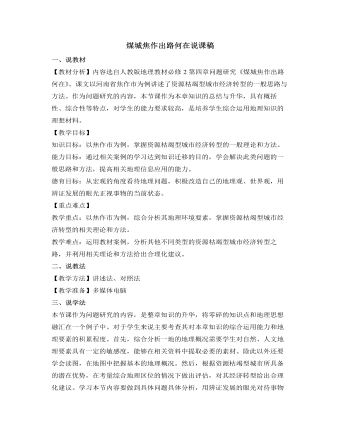
人教版高中地理必修2煤城焦作出路何在说课稿
分析过焦作市的地理概况和产业优势后,就需要针对由于资源枯竭所带来的问题提出合理化的建议。既然是谈经济转型,就应该将话题的范围明确在这一领域内。通过材料3的相关内容,我们了解到焦作市需要在产业结构调整、培育新的优势产业、增强综合竞争力等三个整改方针上下功夫。因而引导学生针对优势与不足提出建议,以三个整改方针为基准,衡量建议的可行性是锻炼学生解决此类问题的有效途径。在此我将教会学生的是解决问题方法而非案例的内容,正所谓“授之以鱼,不如授之以渔”。接下来针对学生的建议和教材资料分析所罗列的10点整改思路,由学生自由发言提出看法,通过教师的指导和学生的讨论,进而确定经济转型建议的具体方案。最后注意将建议与产业优势相对照,看建议是否都是围绕着产业优势而提出的,这样做会加深学生的印象,通过建议和优势的对应关系,将不难找出此类问题的解题思路。
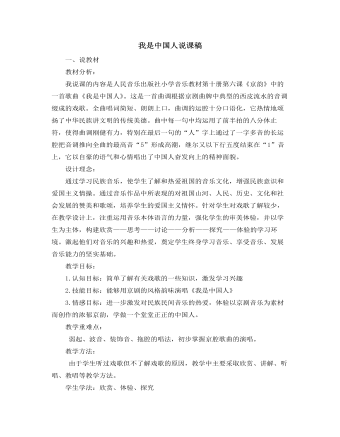
人音版小学音乐五年级下册我是中国人说课稿
5. 跟着范唱,完整地唱好全歌7. .以自豪的情感跟着伴奏带唱好京歌《我是中国人》。(音乐教育以审美为核心,主要作用于人的情感世界,使学生充分体验蕴涵于音乐音响形式中的美和丰富的情感,为音乐所表达的真善美理想境界所吸引、所陶醉,与之产生强烈的情感共鸣,使音乐艺术净化心灵、陶冶情操,以利于学生养成健康、高尚的审美情趣和积极乐观的生活态度。)8.鼓励学生单独演唱,师生共同评价,锻炼学生能够对自己和他人的演唱作简单评价。三、表演唱。因为戏歌和戏曲是分不开得,所以我向学生讲解戏曲中跑圆场这个动作,并辅导学生表演,用于歌曲的前奏。作为本科知识的延续,拓展学生的知识面,用戏歌作为学生走进戏曲的敲门砖。最后教师提出希望,鼓励学生从唱戏歌开始,慢慢地去了解戏曲,学习戏曲,敲开戏曲艺术的大门。
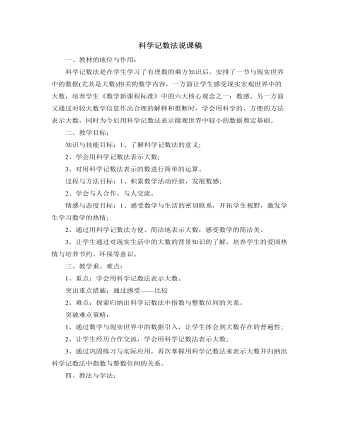
北师大初中数学七年级上册科学记数法说课稿
[设计说明]:只给出情景故事,感知了一个大数,这样还不能引起学生对大数的深刻认识,所以再给出宇宙星空中的这些大数,让学生读读、看看这些数,引起学生强烈的认知上的冲突,形成一种心理上的想读、想写的求知欲望。(二)、引出问题、探索新知在上面的例子中,我们遇到了几个很大的数,看起来、读起来、写起来都不方便,有没有简单的表示法呢?分以下步骤完成。1、回忆100 ,1000,10000,能写成10( )2、300=3×100=3×10( )3000=3×1000=3×10()30000=3×10000=3×10()3、再由学生完成上面4个例子中的数的表示。(学生对160 000 000 000这个数可能表示为、16×1010,教师要利用学生这种错误,强调a的范围)4、教师给出科学记数法表示:a×10( )(1≤a<10)。[设计说明]:通过层层递进的探究设计,启发学生成功地发现“科学记数法”的表示方法,同时又通过学生示错,让学生记住a的范围,体现了以学生为主的探究式教学。
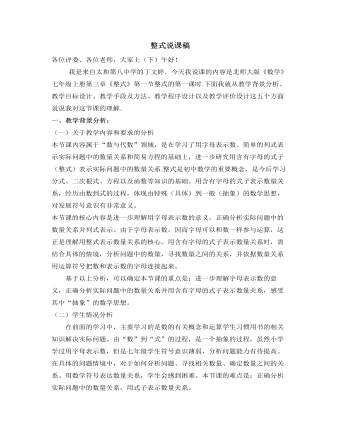
北师大初中数学七年级上册整式说课稿
按此规律,第n个式子是 。师生活动:学生通过观察,分析,归纳发现规律,并用含字母的式子表示一般结论。设计意图:进一步理解字母表示数的意义,理解用含有字母的数学式子表示实际问题中的数量关系的简洁性、必要性和一般性。(四)巩固提升问题:你能给以上这些式子赋予新的含义吗?师生活动:教师举例说明比如:如果p表示我们班的人数,我们班80%的同学喜欢上数学课,那么0.8p 就可以表示我们班喜欢数学课的人数。学生思考、交流后发言五、练习检测(1)5箱苹果重m kg,每箱重 kg ;(2)一个数比a的 倍小5,则这个数为 ;(3)全校学生总数是x,其中女生占总数52%,则女生人数是 ,男生人数是 ;(4)某校前年购买计算机 x 台,去年购买数量是前年的2倍,今年购买数量又是去年的2倍,则学校三年共购买计算机 台;(5)某班有a名学生,现把一批图书分给全班学生阅读,如果每人分4本,还缺25本,则这批图书共 本;(6)一个两位数,十位上的数字为a,个位上的数字b,则这个两位数为 .师生活动:学生板演,师生共同评价总结注意(5)带分数化假分数设计意图:进一步提高用含有字母的式子表示实际问题中的数量关系的能力。
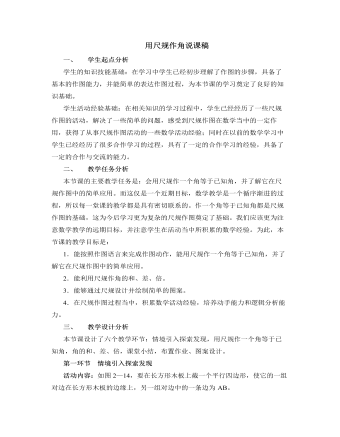
北师大版初中七年级数学下册用尺规作角说课稿
活动目的:通过两个图案设计,一个是让学生独立思考,借助于已经学习的用尺规作线段和角来完成,对本节课的知识进一步巩固应用;另一个是让学生根据作图步骤借助于尺规完成图案,进一步培养学生几何语言表达能力,并积累尺规作图的活动经验。活动注意事项:根据课堂时间安排,可灵活进行处理,既可以作为本节课的实际应用,也可以作为课下的联系拓广,从而使得不同层次的学生都学到有价值的数学。四、 教学设计反思1.利用现实情景引入新课,既能体现数学知识与客观世界的良好结合,又能唤起学生的求知欲望和探求意识。而在了解基础知识以后,将其进行一定的升华,也能使学生明白学以致用的道理、体会知识的渐进发展过程,增强思维能力的培养。同时,在整个探究过程中,怎样团结协作、如何共同寻找解题的突破口,也是学生逐步提高的一个途径。
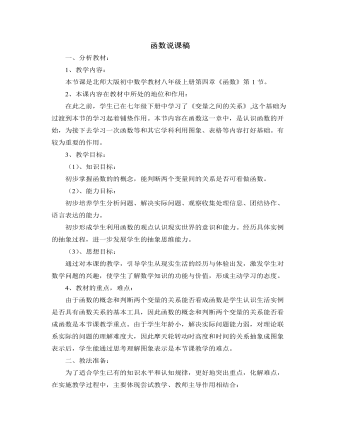
北师大版初中八年级数学上册函数说课稿
然后能通过图象找出变量的对应关系在图象上的体现。3、做一做:课本P154第1小题,学生在课本上填表,让学生通过填表,体会变量之间的相依关系。4、师生小结:和学生一起对刚才的三个例子进行总结,启发学生思考三个例子的相同点和不同点,如表现形式不同,有图象、表格、代数表达式。相同的有它们都是两个变量,确定其中一个变量后就能相应确定另一个变量的值。从而使学生的认识上升一个高度,并掌握函数的概念5、课堂练习:完成课本P155随堂练习。通过本练习的完成巩固概念并会用概念去判断两个变量间的关系是否可看做函数。6、新课巩固:以填空形式对本堂课进行小结,使学生对函数的概念及应用有一定记忆。并通过对最后问题的思考使学生意识到数学来自生活,并能应用于生活。
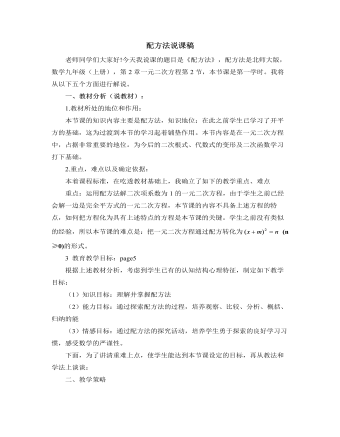
北师大版初中数学九年级上册配方法说课稿
用你的语言描述一下配方法解一元二次方程的基本步骤和需注意的问题。 教师引导学生进行反思、归纳配方法解一元二次方程的基本思路、步骤及注意事项。巩固对课堂知识的理解和掌握,同时进一步体会解一元二次方程时降次的基本策略和转化的思想。 六、布置作业分层布置作业,既巩固本节主要内容,又有让学有余力的学生有思考和提升的空间。思考题为后面深入研究配方法,完善对配方法的认识做准备。 同时让学生感受到数学学习在实际生活中的作用,感受数学的美。五、板书设计我将板书分成了两部分,重点突出这节课用配方法解一元二次方程的步骤,在配以适当的练习,简单明了,重点突出。六、教学评价与反思本节课我根据学生的特点采用合作交流探究式学西方法教学,让学生动起来,感受数学学习的乐趣。让学生更加爱学数学。
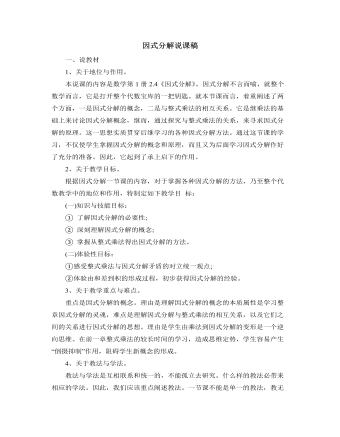
北师大版初中数学九年级上册因式分解说课稿
第三环节。尝试练习,信息反馈。让学生尝试练习:课本p152第3题,并引导中下学生看p152例题,教师及时点拨讲评。△教师安排这一过程,完全放手让学生自主进行,充分暴露学生的思维过程,展现学生生动活泼、主动求知和富有的个性,使学生真正成为学习的主体,使因式分解与整式的乘法的关系得到正强化。第四环节。小结阶段。这是最后的一个环节,教师出示“想一想”:下列式子从左边到右边是因式分解吗,为什么?学生展开讨论,得到下列结论:A.左边是乘法,而右边是差,不是积;B.左右两边都不是整式;C.从右边到左边是利用了因式分解的变形方法进行分解。由此可知,上式不是因式分解。进而,教师呈现因式分解定义。△教师安排这一过程意图是:学生一般到临近下课,大脑处于疲劳状态,注意力开始分散。
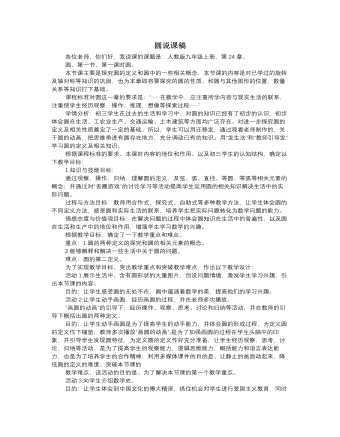
北师大版初中数学九年级下册圆说课稿
活动6:通过随堂小测的方式辨别圆的相关概念。目的:让学生准确地掌握直径与弦,弧与半圆的关系,以及准确理解等圆和等弧的概念。活动7:让学生分组讨论“投圈游戏”,解决生活中的实际问题。目的:提高学生运用所学圆的知识,解决实际问题的能力;也是为了巩固圆的定义,同时再次激发学生的学习兴趣。活动8:给学生一个草坪情境,要求作出半径为5m的圆,并说明原理。目的:提高学生的综合运用能力,并巩固圆的定义。活动9:让学生根据树木的年轮的直径和生长年龄,计算树木每年的生长情况。目的:巩固圆的知识。活动10:让学生回顾本节课的重要内容并布置课后作业。目的:前者的目的是梳理圆及圆的相关元素的概念,便于识记、理解和运用。后者的目的是:第一题,检测学生的动手能力和提高学生学习数学的兴趣;第二题,检测学生对本节课的重要内容的理解情况;第三题,检测学生的综合运用能力。以上是我对本节课内容的理解和设计。

